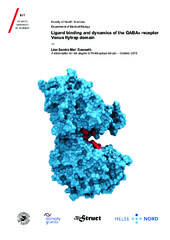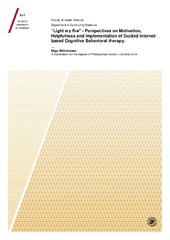Browsing Det helsevitenskapelige fakultet by Title
Now showing items 5492-5511 of 10115
-
Lifestyle changes among people with type 2 diabetes are associated with participation in online groups and time since diagnosis
(Journal article; Tidsskriftartikkel; Peer reviewed, 2021-07-12)<i>Background</i> - For people with Type 2 diabetes (T2D), lifestyle changes may be the most effective intervention. Online groups for people with diabetes holds a great potential to support such changes. However, little is known about the association between participation in online groups and lifestyle changes based on internet information in people with T2D. The aim of this study was to investigate ... -
Lifestyle changes from online information are associated with discussing the information with a doctor A cross-sectional study among members of the Norwegian Diabetes Association
(Master thesis; Mastergradsoppgave, 2020-08-31)Background: The prevalence of diabetes and the use of electronic health (eHealth) are increasing. There are strong indications that lifestyle changes in a positive direction may reduce morbidity and mortality in patients with diabetes. However, little is known about the association between the use of eHealth and lifestyle changes in people with diabetes. Objective: The objective of this study ... -
Lifestyle correlates of eight breast cancer-related metabolites: a cross-sectional study within the EPIC cohort
(Journal article; Tidsskriftartikkel; Peer reviewed, 2021-12-10)Background: Metabolomics is a promising molecular tool for identifying novel etiological pathways leading to cancer. In an earlier prospective study among pre- and postmenopausal women not using exogenous hormones, we observed a higher risk of breast cancer associated with higher blood concentrations of one metabolite (acetylcarnitine) and a lower risk associated with higher blood concentrations of ... -
Lifestyle factors and colorectal cancer: The Norwegian Women and Cancer Study
(Doctoral thesis; Doktorgradsavhandling, 2020-03-27)Colorectal cancer (CRC) is a major global disease. The incidence rate among Norwegian women is currently the highest in the world. Lifestyle factors have a substantial influence on CRC susceptibility. However, it is not clear whether these factors are responsible for the high incidence in Norwegian women, or whether they play a role in CRC survival. This doctoral project investigated lifestyle factors ... -
Lifestyle factors and risk of venous thromboembolism
(Doctoral thesis; Doktorgradsavhandling, 2013-06-13)SUMMARY There is little knowledge about the association between lifestyle factors and risk of venous thromboembolism (VTE). The aim of this thesis was to investigate the relation between coffee consumption, emotional states, cigarette smoking and socioeconomic status and future risk of incident VTE in a prospective, population-based cohort study. Our study population consisted of more than 27 ... -
Lifestyle factors as mediators of area-level socio-economic differentials in cardiovascular disease risk factors. The Tromsø Study
(Journal article; Tidsskriftartikkel; Peer reviewed, 2022-09-24)Introduction: Cardiovascular disease (CVD) is a leading cause of death and disability and living in areas with low socio-economic status (SES) is associated with increased risk of CVD. Lifestyle factors such as smoking, physical inactivity, an unhealthy diet and harmful alcohol use are main risk factors that contribute to other modifiable risk factors, such as hypertension, raised blood cholesterol, ... -
Lifestyle factors as mediators of area-level socioeconomic differentials in mental health and cognitive function: the Tromsø Study
(Journal article; Tidsskriftartikkel; Peer reviewed, 2023-11-22)Introduction - Low socioeconomic status (SES) is associated with poor mental health and cognitive function. Individual-level SES and area-level SES (ASES) may affect mental health and cognitive function through lifestyle. We aimed to quantify the associations of ASES with mental health and cognitive function and examine the mediating role of lifestyle behaviours independent of individual-level SES ... -
Lifestyle factors including diet and biochemical biomarkers in acute intermittent porphyria: Results from a case-control study in northern Norway
(Journal article; Tidsskriftartikkel; Peer reviewed, 2018-12-10)<i>Background</i>: Lifestyle factors, including a low intake of carbohydrates, dieting, alcohol consumption, cigarette smoking and stress are some of the possible triggers of attacks in acute intermittent porphyria (AIP). The influence of lifestyle factors, including energy intake, diet and alcohol consumption on the biochemical disease activity in AIP and biochemical nutritional markers were ... -
Lifestyle interventions to change trajectories of obesity-related cardiovascular risk from childhood onset to manifestation in adulthood: a joint scientific statement of the task force for childhood health of the European Association of Preventive Cardiology and the European Childhood Obesity Group
(Journal article; Tidsskriftartikkel; Peer reviewed, 2023-07-25)There is an immediate need to optimize cardiovascular (CV) risk management and primary prevention of childhood obesity to timely and more effectively combat the health hazard and socioeconomic burden of CV disease from childhood development to adulthood manifestation. Optimizing screening programs and risk management strategies for obesity-related CV risk in childhood has high potential to change ... -
Lifestyle risk factors of self-reported fibromyalgia in the Norwegian Women and Cancer (NOWAC) study
(Journal article; Tidsskriftartikkel; Peer reviewed, 2023-10-11)Background While the aetiology of fibromyalgia syndrome (FM) remains unknown, lifestyle factors have been linked to the disorder. However, there are few studies on the association between lifestyle factors and FM, thus we examine the risk of self-reported fibromyalgia given selected lifestyle factors.<p> <p>Methods We used data from 75,485 participants in the Norwegian Women and Cancer study. ... -
Lifetime alcohol intake, drinking patterns over time and risk of stomach cancer: A pooled analysis of data from two prospective cohort studies
(Journal article; Tidsskriftartikkel; Peer reviewed, 2021-02-07)Alcohol consumption is causally linked to several cancers but the evidence for stomach cancer is inconclusive. In our study, the association between long-term alcohol intake and risk of stomach cancer and its subtypes was evaluated. We performed a pooled analysis of data collected at baseline from 491 714 participants in the European Prospective Investigation into Cancer and Nutrition and the Melbourne ... -
Lifetime alcohol use and overall and cause-specific mortality in the European Prospective Investigation into Cancer and nutrition (EPIC) study
(Journal article; Tidsskriftartikkel; Peer reviewed, 2014) -
Lifetime number of years of menstruation as a risk index for postmenopausal endometrial cancer in the Norwegian Women and Cancer Study
(Journal article; Tidsskriftartikkel; Peer reviewed, 2018-05-21)<p><i>Introduction</i>: Lifetime number of years of menstruation (LNYM) reflects a woman's cumulative exposure to endogenous estrogen and can be used as a measure of the combined effect of reproductive factors related to endometrial cancer (EC) risk.</p> <p><i>Material and methods</i>: We aimed to study the association between LNYM and EC risk among postmenopausal women and calculate the population ... -
Lifetime sunburn trajectories and associated risks of cutaneous melanoma and squamous cell carcinoma among a cohort of Norwegian women
(Journal article; Tidsskriftartikkel; Peer reviewed, 2022-10-05)Importance - To our knowledge, no study has prospectively investigated sunburn patterns over age periods from childhood to adulthood and their associations with skin cancer risk.<p> <p>Objective - To identify lifetime trajectories of sunburns and compare the association between these trajectories and subsequent risk of cutaneous melanoma and squamous cell carcinoma (cSCC).<p> <p>Design, ... -
Lifetime ultraviolet radiation exposure and DNA methylation in blood leukocytes: The Norwegian Women and Cancer Study
(Journal article; Tidsskriftartikkel, 2020-03-11)Ultraviolet radiation (UVR) exposure is a leading cause of skin cancers and an ubiquitous environmental exposure. However, the molecular mechanisms relating UVR exposure to melanoma is not fully understood. We aimed to investigate if lifetime UVR exposure could be robustly associated to DNA methylation (DNAm). We assessed DNAm in whole blood in three data sets (n = 183, 191, and 125) from the Norwegian ... -
Ligand binding and dynamics of the GABAB receptor Venus flytrap domain
(Doctoral thesis; Doktorgradsavhandling, 2019-11-15)<p>The gamma-amino-butyric-acid (GABA) is the main inhibitory neurotransmitter in the central nervous system (CNS) and exerts its physiological role by binding to the ionotropic GABA<sub>A</sub> and GABA<sub>C</sub> receptors and the metabotropic GABA<sub>B</sub> receptor (GABA<sub>B</sub>-R). The GABA<sub>B</sub>-R is an obligate heterodimer that belongs to class C of guanine-binding proteins ... -
Ligand-guided homology modelling of the GABAb2 subunit of the GABAb receptor
(Journal article; Tidsskriftartikkel; Peer reviewed, 2017-03-21)γ-aminobutyric acid (GABA) is the main inhibitory neurotransmitter in the central nervous system, and disturbances in the GABAergic system have been implicated in numerous neurological and neuropsychiatric diseases. The GABA<sub>B</sub> receptor is a heterodimeric class C G protein-coupled receptor (GPCR) consisting of GABA<sub>B1a/b</sub> and GABA<sub>B2</sub> subunits. Two GABA<sub>B</sub> receptor ... -
Light curing composite -a thermal risk for the pulp?
(Master thesis; Mastergradsoppgave, 2017-05-19)Introduction and objectives: Light curing has shown to be a risk for the pulp as well as for superficial tissues due to high temperatures. The aim of this study was to evaluate temperature changes in a low viscosity bulk fill composite and the temperature effect on the pulp chamber temperature during light curing using a LED light curing device (LCU). The null hypothesis stated was that the composite ... -
“Light my fire” - Perspectives on Motivation, Helpfulness and Implementation of Guided Internet-based Cognitive Behavioral therapy.
(Doctoral thesis; Doktorgradsavhandling, 2015-03-13)Depression is common and imposes tremendous burdens for patients, their family and society. Implementation of internet-based cognitive behavioural therapy (ICBT) within general practice is recommended. Better results have been shown for treatment with ICBT when support is given, and therefore there is interest in exploring guided ICBT as an affordable alternative for treatment in the early stage ... -
Light-curing units used in dentistry: Effect of their characteristics on temperature development in teeth
(Journal article; Tidsskriftartikkel; Peer reviewed, 2021-09-25)This study aimed to investigate pulp chamber and surface temperature development using different LED light curing units (LCUs). Eight brands of LED-LCUs were tested in a laboratory bench model. The pulp chamber and surface temperature were recorded with a type T thermocouple and infrared cameras, respectively. The highest pulp chamber and surface temperature increase was 6.1±0.3°C and 20.1±1.7°C, ...


 English
English norsk
norsk


















